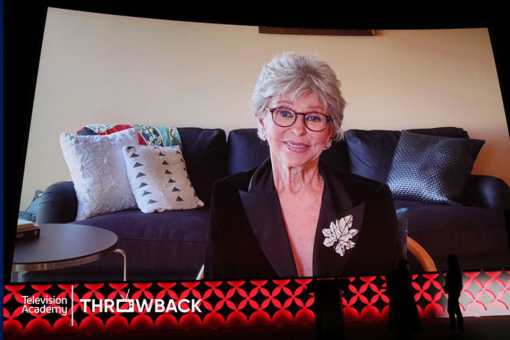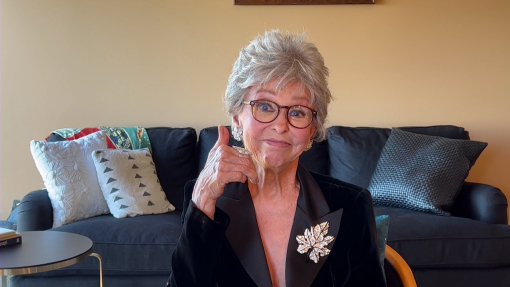“I just want them to remember me one hundred years from now. I don’t care that they’re not able to quote a single line that I’ve written. But just that they can say, ‘Oh, he was a writer.’ That’s sufficiently an honored position for me.” — Rod Serling
Rod Serling fashioned much of the art of American television. Whether he was writing a realistic drama for one of the early live anthology shows, or spinning a dark hallucinatory tale for The Twilight Zone, he lifted television programming to a level that remains uneclipsed by the passage of time.
Gifted with an extraordinary imagination, he was also a kind of television Renaissance man, an artist active in all phases of the medium as a dramatist, a host, an on-camera narrator, and a producer who pioneered the concept of imaginative drama on prime-time television.
Born Rodman Edward Serling in Syracuse, New York, on Christmas Day 1924 (“I was a Christmas present that was delivered unwrapped,” he would later say), Serling grew up on a diet of fantasy, whimsy, science-fiction, and horror: Amazing Stories, Astounding Stories, Weird Tales — “all of the pulps,” according to his older brother, novelist Bob Serling. “If we saw a movie together,” adds Bob, “we’d come home and act it out, just for the two of us. Our bikes became airplanes with machine guns on them. We were always playing cowboys.”
The playacting, the searching for adventure, even the testing of one’s limits began fueling Serling’s imagination and his interests. For instance, after he graduated from high school, he enlisted in the U.S. Army and immediately began to test his physical limits in basic training by taking up boxing for extra money and extra points. After winning 17 out of 18 bouts, he left basic to join the 11th Airborne Division as a paratrooper — again in some apparent attempt to test his physical and emotional limits.
In 1946, after his discharge from the military, Serling enrolled in his brother’s alma mater, Antioch College in Yellow Springs, Ohio, where he majored in language and literature, and haunted the campus radio workshop. Fulfilling his need for self-expression, he wrote radio scripts and directed and acted in various productions at WJEM in nearby Springfield, Ohio.
While he was still a student, Serling won second prize for a radio script that was broadcast on the popular Dr. Christian show. That was in 1949, the year he also sold two radio scripts to Grand Central Station. Then, even as he was savoring these triumphs, he concocted another test for himself. In 1950, he wrote his first television script, “Grady Everett for the People,” which he sold to NBC’s Stars Over Hollywood.
After graduating from college, Serling moved to Cincinnati to take a job as a staff writer at WLW radio station. He turned out documentaries about nearby towns and wrote phony testimonials for patent medicines, all the while keeping an eye on the latest developments in television and longing to find a niche for himself in the burgeoning industry.
In 1950, America did not yet have nationwide television. The East and the Midwest had been linked the previous year, but coast-to-coast transmissions were still another year away. Moreover, television programming was limited, although each new season offered the ever-growing and largely affluent television audience a varied menu of dramatic anthology shows. CBS’s Studio One, the granddaddy of them all, had premiered in 1948. Its success initiated the development of others. By 1951, the year Serling left Cincinnati to test his mettle in New York as a freelance television writer, dramatic anthology shows were as numerous as today’s ubiquitous soaps.
During his first year in New York, Serling contributed to many of those shows: Kraft Television Theatre, Hallmark Hall of Fame, Lux Video Theatre, and Studio One. Slowly building a solid reputation as a writer, he labored long and somewhat anonymously in the anthology vineyards until 1955, when NBC’s Kraft Television Theatre broadcast Patterns, his 72nd script. Besides garnering him his first widely based critical acclaim, the teleplay about corporate power plays won him his first of six Emmys and pressured him, inevitably perhaps, “to prove, first to others and then to myself…,” he once recalled, “that Patterns wasn’t all I had.”
He need not have worried on that score. On October 11, 1956, CBS’s then brand-new Playhouse 90 telecast Requiem for a Heavyweight, Serling’s powerful drama about a boxer’s rapid fall as a man. Starring Jack Palance, the teleplay electrified the nation’s viewers, won Serling his second Emmy, and assured him his place among the golden age’s greatest dramatists. Serling soon followed Requiem with other distinguished fare: his Emmy-winning The Comedian (1957), adapted from Ernest Lehman’s short story of the same name; The Dark Side of the Earth (1957); A Town Turned to Dust (1958); The Rank and File (1958); and The Velvet Alley (1959).
By the late 1950s, however, his patience with live anthology drama had been nearly exhausted. Angered by sponsors’ mounting interference with his scripts, Serling began investigating other creative outlets. He turned to science-fiction and fantasy-based drama in order to explore such controversial subjects as racism, Nazism, and economic greed — subjects that jittery sponsors often vetoed as inappropriate.
Refusing to follow the example of many of his colleagues who had drifted toward the movies or the stage, Serling chose to remain in television. His choice led directly to the birth of The Twilight Zone, a show that permanently enlarged television’s canvas by offering a new kind of fare for prime-time viewers.
The Twilight Zone, however, nearly did not happen. After encountering CBS’s indifference to the concept, Serling finally got Westinghouse Desilu Playhouse to produce the script “The Time Element,” which was intended to have been the pilot for The Twilight Zone. To the network’s surprise, the telecast of The Time Element produced good newspaper reviews and an avalanche of mail.
Impressed, CBS experienced a complete change of heart about Serling’s wish to produce science fiction and fantasy on prime time. Another pilot for The Twilight Zone was ordered, contracts drawn up (Serling and CBS would each own 50 percent of the series), and filming begun. On October 2, 1959, the show premiered and took off on a flight that has not yet ended.
“There is a fifth dimension beyond that which is known to man,” Serling announced in the now-familiar opening narration to the show. “It is a dimension as vast as space and as timeless as infinity. … This is the dimension of imagination. It is an area we call The Twilight Zone.”
Few of the tales spun from the Emmy-winning show have grown stale during the passage of years. The story of the doomed ventriloquist transformed into his own dummy still enthralls us. The tale of the camera that takes instant photos of events five minutes into the future still hold us in its power. The story of the passenger airplane swept against its will into some prehistoric age continues to frighten us.
After the show ended its spectacular run in the originals on May 8, 1964, its long-distance gallop across the years began. Today, thanks to syndication rights, the show continues to captivate new generations of viewers worldwide.
Following The Twilight Zone, Serling won his sixth Emmy for It’s Mental Work (1964), a story about a bar owner who suffers a heart attack, telecast on NBC’s Bob Hope Presents The Chrysler Theater. He served a two-year term as president of the National Academy of Television Arts and Sciences from 1965 to 1966 and continued writing, most notably Certain Honorable Men (1968), a political drama starring Van Heflin and Peter Fonda, and A Storm in Summer (1970), starring Peter Ustinov in a story about a confrontation between a Jewish adult and a black youth.
Serling’s name was also associated with another television series, NBC’s Night Gallery, a collection of supernatural vignettes that ran from December 16, 1970, to August 12, 1973. He hosted the show and wrote some of its scripts, but unlike his contribution to The Twilight Zone, had no hand in the show’s production.
During his last years, he performed frequently in commercials and narrated documentaries, including Jacques Cousteau oceanographic specials.
Rod Serling, an artist who made an indelible imprint on American television with the power of his imagination and the force of his humanity, died on June 28, 1975.
This tribute originally appeared in the Television Academy Hall of Fame program celebrating Rod Serling's induction in 1985.










